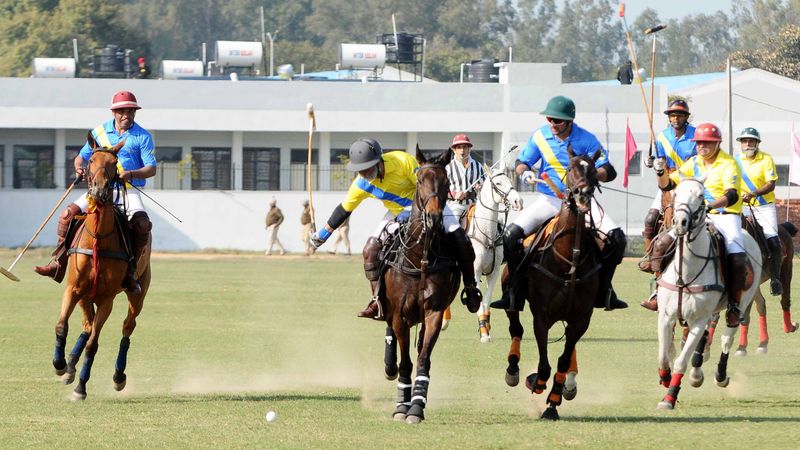A HORSE doesn’t know your money or title, it only respects trust and skill, says Sharad Saxena, a member of the Indian Polo Association (IPA) Rules Committee, setting the tone for changing the rules of the game — how polo is viewed, played and taken up as a competitive sport. The dynamic makeover has inherent challenges, like the public perception that polo is nothing but an indulgence of the rich and famous, a field game of the elite. The answer to that is to engage younger, more diverse audiences, as well as nurture a grassroots love for polo and equestrian culture.
In 2023, the IPA launched the Indian Arena Polo League in Delhi and Jaipur — a televised, shorter format designed to make polo more accessible and exciting for modern viewers. Building on this momentum, the Polo Premier League (PPL) debuted last month as India’s first domestic arena polo competition.
Played on smaller, enclosed fields with three-member teams, arena polo offers a faster, more spectator-friendly format. Earlier, in March, polo made a grand reappearance in Punjab during the vibrant Holla Mohalla festival at Anandpur Sahib. The Punjab Arena Polo Challenge Cup featured a thrilling match between the Anandpur Sahib team and the newly recognised Chandigarh polo team. The event was organised with support from international player Sodhi Vikram Singh and the newly IPA-affiliated Chandigarh Polo Club.
Punjab’s embrace of arena polo is significant. The format extends the playing season from winter up to nine months, making polo accessible to more youth and local enthusiasts. Arena polo’s smaller fields as well as teams means fewer ponies are required, reducing costs and logistical barriers — crucial in democratising the sport.
Col Tarsem Singh Warraich (retd), former India captain and joint secretary of the Punjab Equestrian Association, firmly believes that the future lies in building regional structures and encouraging young people to learn riding, care for horses, and see polo as a path of purpose. “Punjab can actually become a polo powerhouse — not just in Patiala, but across rural and semi-urban areas where fitness, horsemanship, and discipline are already part of the culture. We want village youth to see it as their game, a sport of warriors, rooted in our tradition,” he says.
Arena polo, in particular, has great potential, says Col Warraich. “It’s more spectator-friendly. Smaller fields, closer proximity to the action and simplified rules make it easier for the public to understand and enjoy.”
Polo in India is evolving across several layers — from local polo played in regions like Manipur and Zanskar, to professional polo with sponsorships and prize money, and social polo, often dominated by high-profile events and Page 3 appearances. While social visibility has helped the game reach the masses, it has also taken the focus away from polo as a serious competitive sport. As an expert points out, “Polo should be featured on the sports pages, not just the lifestyle section — it is the king of sports.”
Delhi and Jaipur remain key hubs of competitive polo, while Hyderabad sustains interest through arena polo. In the South, activity is limited, though Chennai recently reopened its polo ground after 1998, and Bengaluru maintains a small club.
The Indian Army remains a pillar of consistency in the sport. Historically, Jodhpur’s cavalry regiments were among the first to adopt polo formally, recognising its role in sharpening horsemanship skills. This tradition traces its roots to both royalty and the British military, where young princes and princesses were trained in riding for both defence and dignity.
The Army Polo and Riding Centre in Delhi is open to civilians. As a polo veteran puts it: “Talent doesn’t look at money — it looks for opportunity. Give polo that, and we can do miracles.” IPA’s Saxena stresses, “Polo is exclusive, not elite. It takes willpower and physical strength.”
Leading the modern revival is Sawai Padmanabh Singh of Jaipur, former captain of the Indian team. Known for resurrecting the historic Jaipur Polo Team, he champions inclusive polo through high-goal tournaments, ladies’ and youth events, and affordable training programmes under the Rajasthan Polo Club. His vision is clear: polo should not be a game of privilege but a passion open to anyone willing to ride into its legacy on their own terms.
Col Ravi Rathore (retd), Arjuna awardee and former Indian polo team captain, believes that arena polo is a game-changer. “It invites more players and fans, and ensures polo isn’t confined to royal estates or military stables,” he says.
Polo’s origins in India can be traced back to the northeastern state of Manipur, where the sport was traditionally played as Sagol Kangjei — or ‘horse hockey’. Seven riders competed on each side, without goalposts, striking a root-ball with bamboo mallets across boundary lines for scoring. Players would be dressed in dhotis and turbans, with minimal protective gear. It was a sport played not only by village youths but by the kings themselves.
The essence of Sagol Kangjei went beyond competition. “It was meant to test courage, dexterity, and the harmonious relationship between human and horse,” explains Ningthoukhongjam Ibungochoubi, secretary general of the Manipur Equestrian Association. “The sport was a peacetime war exercise where kings could see who was the best warrior.”
In 1854, Lt Joseph Sherer of the Sylhet Light Infantry witnessed the thrilling spectacle of Manipuri riders. He, alongside Capt Robert Stewart, Assistant Deputy Commissioner of Cachar, began playing with Manipuri players. This collaboration led to establishment of the Silchar Kangjei Club in 1859, the world’s first modern polo institution, later known as the Cachar Club.
Soon after, polo found its way to Calcutta, where the Calcutta Polo Club was founded in 1862. Recognised as the oldest continuously operational polo club worldwide, it became the cradle of modern polo, hosting the prestigious Ezra Cup from 1880.
The Calcutta Polo Club played a pivotal role in transforming the tribal game into a structured sport. It standardised rules, reduced team sizes from seven to four riders, introduced goalposts, saddles, and formal attire, effectively launching the internationally recognised version of polo we know today.
A curious linguistic twist also emerged from this colonial encounter. The British, struggling to pronounce ‘Sagol Kangjei’, borrowed the word ‘polo’ from the Balti term ‘pulu’, meaning ball. This simpler term quickly became universal.
By the early 20th century, polo had blossomed into a symbol of royal prestige and elite sport. Princely states such as Patiala, Jaipur, Jodhpur, Alwar and Kashmir sponsored and fielded formidable teams. One legendary figure was Maharaja Rajinder Singh of Patiala, hailed as India’s finest polo player. His team’s 1922 match at Delhi’s Red Fort attracted an astounding lakh-plus spectators and 47 maharajas — an iconic moment etched in polo folklore.
Meanwhile, Jaipur’s Maharaja Man Singh and Jodhpur’s Rao Raja Hanut Singh elevated India’s reputation on the global stage by leading their teams to victory in England’s prestigious Hurlingham Cup in 1933.
In 1892, the Indian Polo Association was established, institutionalising polo by uniting royal, military and civilian teams under a single umbrella.
Though interrupted by war, polo’s continuity was secured when the IPA revived the Indian Polo Championship in 1956. The following year, an Indian national team with players from Jaipur triumphed at the World Championship in Deauville, France.
Even as cavalry regiments were mechanised post-Independence, Indian Army units such as the Central India Horse and PAVO’s Cavalry preserved polo’s traditions — maintaining stables, training riders, and sustaining the sport’s spirit. Col Rathore, who is currently coaching Singapore’s national polo team, shares, “Polo was more than just a game for the Army and royalty — it was a discipline, a tradition that built character, leadership, and camaraderie. Those regiments kept the spirit alive when polo might otherwise have faded.”
Today, polo enjoys a global footprint, professionally played in 77 countries, with major circuits in Argentina, the UK, the US, France, and India. Within India, the IPA oversees 33 polo clubs spread across the country, including hubs in Leh, Udaipur, Jodhpur, Hyderabad, Bengaluru, Ahmedabad and Chandigarh. Imphal continues to host the internationally renowned Manipur International Polo Tournament at the historic Mapal Kangjeibung.
Once a game of kings and cavalry, polo today is galloping into the hearts of India’s youth, women and communities far beyond traditional bastions. Children across India are discovering the joy and life lessons of horseback riding — from the thrill of the gallop to the discipline of horse care. Equestrianism is blossoming into a cherished part of childhood, promising a vibrant future for the sport and its culture.
“Polo’s future lies with the masses,” says Keshav Bangur, president of the Calcutta Polo Club, “and that’s why we’ve been reaching out to schools through short training programmes. Students watch videos, visit the polo ground, and even try their hand at arena polo. The idea is to nurture talent, remove fear, and make them comfortable around horses. They learn how to feed and approach them, and slowly develop interest and confidence. Even as spectators, they begin to enjoy the sport better.”
Col Rathore sums it up, “Polo in India stands at a crossroads — honouring a rich heritage while embracing new players and formats. The future is bright if we keep the sport inclusive, passionate, and rooted in its unique culture.”
In the spirit of that vision, polo continues to evolve — a timeless legacy, galloping boldly into the future.
— The writer is a freelance contributor
No gender barrier
Horses respond only to the rider’s skill and confidence, and there is no place for any gender exclusion in polo.
Polo is unique among sports because men and women compete together — there’s no gender barrier, as horses respond only to their rider’s skill and confidence. Olympic equestrian events, such as show jumping and dressage, reflect this equality. Although polo last appeared in the Olympics in 1936, its inclusion again is a dream for many riders in India.
Polo remains a demanding and high-risk sport, not just because of the physical rigour but due to the commitment needed in caring for the horse.
Today, around 10 women actively play polo across the country, challenging stereotypes and inspiring new generations. At the forefront is Rinaa Shah, one of India’s first professional female polo players known to have also popularised the sport with fashion.
Monica Saxena, who took up polo after marriage and has captained the women’s team, began riding after her second child. “It took commitment, but once you overcome the fear — of a 600-kilo horse thundering at 40 feet per second — you discover your true strength,” she says.
In polo, players start with a handicap of -2, progressing only through years of hard-earned skill and discipline. Unlike basic horse riding, polo demands reflexes, technical control, and strong coordination.
Women’s polo is a movement of empowerment that fuses ancient heritage, social inclusion, and environmental conservation. The Manipur Statehood Day Women’s Polo Tournament symbolises this spirit.
Sanjula Mann, a 21-year-old player from Jaipur, shares her perspective. “Yes, money matters because it’s an expensive sport. But unconditional family support, grit and determination are just as important.”


